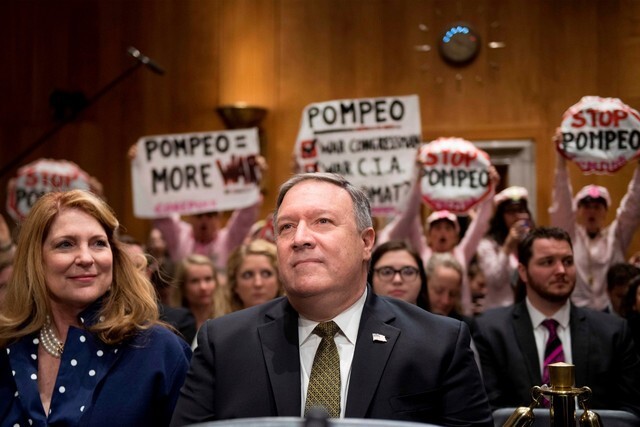hankyoreh
Links to other country sites 다른 나라 사이트 링크
Trump administration officials express optimism over US-North Korea summit

High-ranking officials in the US Donald Trump administration – including Trump himself, Secretary of State nominee Mike Pompeo, and Secretary of Defense James Mattis – offered optimistic predictions on Apr. 12 for an upcoming North Korea-US summit. During a Senate Foreign Relations Committee confirmation hearing that day, Pompeo said he was “optimistic” that Washington could set conditions through the summit with North Korean leader Kim Jong-un to “set us down the course to achieve a diplomatic outcome that America and the world so desperately need.”
Pompeo added that “no one is under any illusions” that the two sides would immediately reach a comprehensive deal through the summit. But he added that they might “set out the conditions that would be acceptable to each side for the two leaders that will ultimately make the decision about whether such an agreement can be achieved and then set in place.”
With his optimistic predictions for the North Korea-US summit where a denuclearization deadline and basic principles on denuclearization and compensation are to be discussed, Pompeo was seen as hinting that a specific road map may be discussed through later working-level talks.
Explaining that the US administration wants to “get the outcome permanently, irreversibly, that . . . we hope to achieve” before offering rewards to North Korea, Pompeo added, “It is a tall order, but I am hopeful that President Trump can achieve that through sound diplomacy [personally or through the State Department].”
But when asked by Senator Cory Gardner if complete, verifiable, and irreversible denuclearization was the US’s only goal with North Korea, Pompeo remained cautious.
“We need to ensure that we continue to provide a strategic deterrence framework for our allies in the region: the South Koreans, the Japanese and others as well,” he said.
“But the purpose of the meeting is to address the threat to the United States,” he added.
Pompeo also asserted that he had “never advocated for regime change” in North Korea and was not advocating for it now. His message contrasted with remarks made during a July 2017 security forum in Colorado, where he appeared to hint that regime change in Pyongyang was necessary.
“The most important thing we can do is separate . . . capacity and someone who might well have intent, and break those two apart,” Pompeo said at the time.
But when asked about the possibility of military action if economic pressure and diplomatic efforts with North Korea fail, Pompeo indirectly replied that Mattis had been directed to provide a list of options to achieve the President’s goals in the event that diplomatic measures proved unsuccessful.
During a meeting with state governors at the White House the same time, Trump voiced hopes for the upcoming summit with North Korea.
“Meetings are being set up right now between myself and Kim Jong-un,” he said. “I think it will be terrific.”
“I think we’re going with a lot of respect,” he added about the talks.
In a House Armed Services Committee hearing the same day, Mattis said, “We're all cautiously optimistic that we may be on the right path for the denuclearization of the Korean peninsula.”
By Yi Yong-in, Washington correspondent
Please direct questions or comments to [english@hani.co.kr]

Editorial・opinion
![[Column] Season 2 of special prosecutor probe may be coming to Korea soon [Column] Season 2 of special prosecutor probe may be coming to Korea soon](https://flexible.img.hani.co.kr/flexible/normal/500/300/imgdb/original/2024/0426/3317141030699447.jpg) [Column] Season 2 of special prosecutor probe may be coming to Korea soon
[Column] Season 2 of special prosecutor probe may be coming to Korea soon![[Column] Park Geun-hye déjà vu in Yoon Suk-yeol [Column] Park Geun-hye déjà vu in Yoon Suk-yeol](https://flexible.img.hani.co.kr/flexible/normal/500/300/imgdb/original/2024/0424/651713945113788.jpg) [Column] Park Geun-hye déjà vu in Yoon Suk-yeol
[Column] Park Geun-hye déjà vu in Yoon Suk-yeol- [Editorial] New weight of N. Korea’s nuclear threats makes dialogue all the more urgent
- [Guest essay] The real reason Korea’s new right wants to dub Rhee a founding father
- [Column] ‘Choson’: Is it time we start referring to N. Korea in its own terms?
- [Editorial] Japan’s rewriting of history with Korea has gone too far
- [Column] The president’s questionable capacity for dialogue
- [Column] Are chaebol firms just pizza pies for families to divvy up as they please?
- [Column] Has Korea, too, crossed the Rubicon on China?
- [Correspondent’s column] In Japan’s alliance with US, echoes of its past alliances with UK
Most viewed articles
- 1AI is catching up with humans at a ‘shocking’ rate
- 2Korea’s 1.3% growth in Q1 signals ‘textbook’ return to growth, says government
- 3[Column] Park Geun-hye déjà vu in Yoon Suk-yeol
- 4[Column] Season 2 of special prosecutor probe may be coming to Korea soon
- 5No good, very bad game for Korea puts it out of Olympics for first time since 1988
- 6Marriages nosedived 40% over last 10 years in Korea, a factor in low birth rate
- 7Division commander ordered troops to enter raging flood waters before Marine died, survivor says
- 81 in 5 unwed Korean women want child-free life, study shows
- 9[Column] Has Korea, too, crossed the Rubicon on China?
- 10Will NewJeans end up collateral damage in internal feud at K-pop juggernaut Hybe?